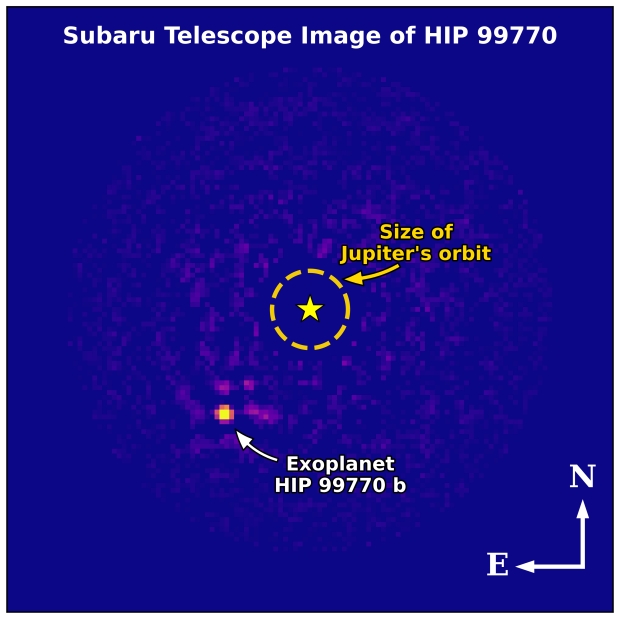It took a combination of astrometry and direct imaging to nail down exoplanet HIP 99770 b in Cygnus, and that’s a tale that transcends the addition of a new gas giant to our planetary catalogs. Astrometry measures the exact position and motion of stars on the sky, so that we are able to see the influence of an as yet unseen planet. In this work, astrometrical data from both the ESA Gaia mission and the earlier Hipparcos mission flag a world that is directly imaged by the Subaru Telescope extreme adaptive optics system, which enabled its near-infrared CHARIS spectrograph to see the target.
Supporting work at the Keck Observatory using its Near-Infrared Camera and Keck II adaptive optics system allowed in combination with the CHARIS spectrum the discovery of the presence of water and carbon monoxide in the atmosphere, while the temperature was shown to be about ten times hotter than that of Jupiter. The joint measurements revealed a planet some 14-16 times the mass of Jupiter, in a 16.9 AU orbit around a star with twice the Sun’s mass and 13.9 times its luminosity.
Thayne Currie (Subaru Telescope) is lead author of the study:
“Performing both direct imaging and astrometry allows us to gain a full understanding of an exoplanet for the first time: measure its atmosphere, weigh it, and track its orbit all at once. This new approach for finding planets prefigures the way we will someday identify and characterize an Earth-twin around a nearby star.”

Image: Infrared image of HIP 99770 taken by the Subaru Telescope. The bright host star at the position marked with * is masked. The dashed ellipse shows the size of Jupiter’s orbit around the Sun for scale. The arrow points to the discovered extrasolar planet HIP 99770 b. Credit: T. Currie/Subaru Telescope, UTSA.
We’ve retrieved direct images of gas giants before, including massive planets around HR8799, the first such worlds detected with the method, relying on advances in adaptive optics systems for ground-based telescopes. But without astrometrical data, astronomers selected targets based on properties like age and distance, producing a small harvest of exoplanets. In this work, astrometry is first used to reveal a likely planetary system by virtue of its star’s motion, allowing the follow-up discovery.
The direct imaging program at the Subaru Telescope (like Keck, at the summit of Mauna Kea in Hawai?i) relies on the extreme adaptive optics system called SCExAO, which filters out the turbulence caused by Earth’s atmosphere. Astrometrical data from Gaia identify stars with telltale gravitational influences that can then be imaged, an approach far more likely to produce exoplanet results than the kind of ‘blind surveys’ earlier in use. One day we may well be using observatories like Earth-based Extremely Large Telescopes or a space observatory like the projected Habitable Worlds Observatory to image an Earth-like world. Thus Motohide Tamura (University of Tokyo):
“The indirect detection method will point us to a star around which a rocky, terrestrial planet could be imaged. Once we know when to look, we hope to learn whether this planet has an atmosphere compatible with life as we know it on Earth.”
The discovery is reported in Currie et al., “Direct imaging and astrometric detection of a gas giant planet orbiting an accelerating star,” Science Vol. 380, Issue 6641 (13 April 2023), 198-293 (abstract).



See https://arxiv.org/abs/2212.00034 for the paper.
What surprised me is that this isn’t considered a brown dwarf. It has more than 13 Jupiter masses, and though it receives little more light than Jupiter, it is somewhere around 1300 K … hotter than the surface of Venus, even on the hot side for a class T star. Apparently there is more ongoing debate about the definition of a brown dwarf than I realized ( https://arxiv.org/abs/1401.7559 ), and I’m getting the impression any “brown dwarf” orbiting another star is being called a giant planet?
131 light years away (approximately).
Well, hopefully some day we can begin to find better ways to see planets that might be more like our own. The methods currently use are biased to giant planets in close orbits. Studying these is totally important and legit! Just not what Kepler was hoping for.
Mike, this was puzzling many on Twitter as well. The authors do explain their recommendation to raise the mass for the definition of “planet” not just for 29 Cygni b but for others. (at least the lead author did, over in Twitter)
I’m more miffed that they refuse the Flamsteed designation, which is the historian-friendly means to mark a star(system) and, besides, tells us roughly where in the sky it is.